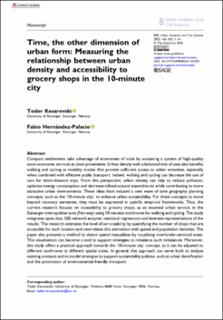| dc.contributor.author | Kesarovski, Todor Milkov | |
| dc.contributor.author | Hernandez-Palacio, Fabio Alberto | |
| dc.date.accessioned | 2022-09-07T11:23:11Z | |
| dc.date.available | 2022-09-07T11:23:11Z | |
| dc.date.created | 2022-09-06T11:45:27Z | |
| dc.date.issued | 2022-05-25 | |
| dc.identifier.citation | Kesarovski, T., & Hernández-Palacio, F. (2022). Time, the other dimension of urban form: Measuring the relationship between urban density and accessibility to grocery shops in the 10-minute city. Environment and Planning B: Urban Analytics and City Science, 23998083221103259. | en_US |
| dc.identifier.issn | 2399-8083 | |
| dc.identifier.uri | https://hdl.handle.net/11250/3016292 | |
| dc.description.abstract | Compact settlements take advantage of economies of scale by sustaining a system of high-quality socio-economic services at close proximities. Urban density with a balanced mix of uses also benefits walking and cycling as mobility modes that provide sufficient access to urban amenities, especially when combined with effective public transport. Indeed, walking and cycling can decrease the use of cars for short-distance trips. From this perspective, urban density can help to reduce pollution, optimise energy consumption and decrease infrastructural expenditures while contributing to more attractive urban environments. These ideas have induced a new wave of time geography planning concepts, such as the ‘10-minute city’, to enhance urban sustainability. For these concepts to move beyond visionary narratives, they must be expressed in specific empirical frameworks. Thus, the current research focuses on accessibility to grocery shops, as an essential urban service, in the Stavanger metropolitan area (Norway) using 10 minutes isochrones for walking and cycling. The study integrates open data, GIS network analyses, statistical regressions and bivariate representations of the results. The research estimates the level of serviceability by quantifying the number of shops that are accessible for each location and interrelates this estimation with spatial and population densities. The paper also presents a method to detect spatial inequalities by visualising over/under-serviced areas. This visualisation can become a tool to support strategies to rebalance such imbalances. Moreover, this study offers a practical approach towards the ‘10-minute city’ concept, as it can be adjusted to different isochrones at different spatial scales. In general, this approach can serve both to analyse existing contexts and to model strategies to support sustainability policies, such as urban densification and the promotion of environmental-friendly transport. | en_US |
| dc.language.iso | eng | en_US |
| dc.publisher | SAGE Publications | en_US |
| dc.rights | Navngivelse 4.0 Internasjonal | * |
| dc.rights.uri | http://creativecommons.org/licenses/by/4.0/deed.no | * |
| dc.subject | urban density | en_US |
| dc.subject | 10-minute city | en_US |
| dc.subject | time geography | en_US |
| dc.subject | accessibility | en_US |
| dc.subject | GIS | en_US |
| dc.title | Time, the other dimension of urban form: Measuring the relationship between urban density and accessibility to grocery shops in the 10-minute city | en_US |
| dc.type | Journal article | en_US |
| dc.type | Peer reviewed | en_US |
| dc.description.version | publishedVersion | en_US |
| dc.rights.holder | © The Author(s) | en_US |
| dc.subject.nsi | VDP::Social science: 200::Urbanism and physical planning: 230 | en_US |
| dc.subject.nsi | VDP::Technology: 500 | en_US |
| dc.source.pagenumber | 1-16 | en_US |
| dc.source.journal | Environment and planning. B: Urban analytics and city science | en_US |
| dc.identifier.doi | 10.1177/23998083221103259 | |
| dc.identifier.cristin | 2049156 | |
| cristin.ispublished | true | |
| cristin.fulltext | original | |
| cristin.qualitycode | 2 | |

